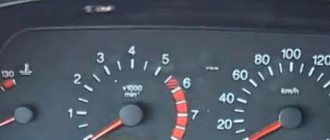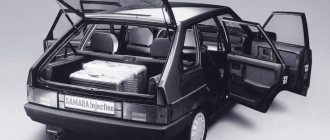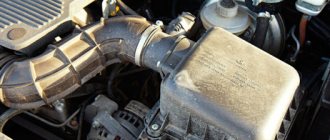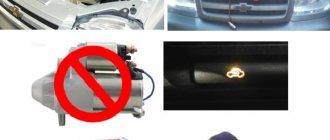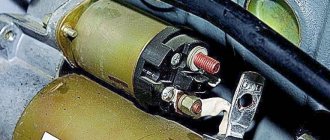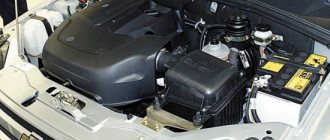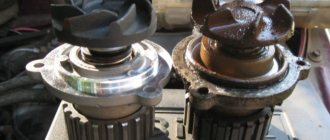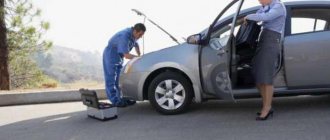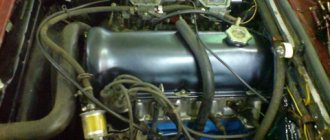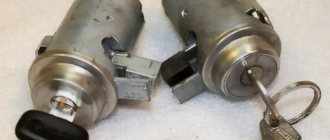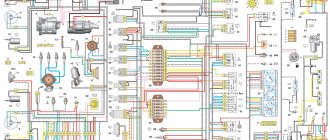Often, owners of a VAZ 2121 or 2131 SUV encounter problems with starting the engine. For example, when you turn the ignition key, the starter does not turn. Let's look at possible problems with the Lada 4×4 starter and ways to solve them.
Silence when trying to start the engine
The Niva crankshaft cannot be turned by the starter.
There may be several reasons:
- Blown fuse.
- Poor contact between battery terminals.
- The battery is completely discharged.
- Failure of the starter solenoid relay.
- Failure of the intermediate relay that switches the starter circuit.
First of all, you should pay attention to the dashboard. When you turn on the ignition or the main electrical circuit in the engine, the lamps should light up on the dashboard or information should appear on the on-board computer, if we are talking about the Chevrolet Niva.
If this does not happen, the cause should be sought in the fuse box and in the battery contacts. During operation, oxides may form on these contacts, increasing the resistance. Loose contact connections can lead to sparking and burning.
If no blown fuses are found, you should check the reliability of the “+” contacts of the battery with the central wire and the “-” contacts with the vehicle ground.
To eliminate the malfunction, be sure to replace the fuses and clean the contacts. It would be a good idea to acquire even the cheapest tester in order to quickly check the presence of voltage in the electrical circuits of the car.
Troubleshooting electrical equipment
Battery
The battery rarely discharges suddenly. Often starting becomes difficult due to low starter speed. But there are also cases when the battery dies in a very short time. When you turn the ignition key, the dashboard may “come to life”, but when you try to turn on the starter, all the lights go out. This is an indicator of battery discharge. As a last resort, you can turn on the headlights and judge the condition of the battery by the brightness of the lamps. The way out is to charge the battery or replace it.
Starter
If the battery is in order, and clicks are heard when you turn the key, then they indicate a fault with the starter. If nothing happens (no reaction), then before sinning on the starter, you need to check the reliability of the connection of the supply wire to the starter solenoid relay. If the starter has become unusable, then its repair is possible, but it depends on the reasons, of which there may be several.
Clicking noises when trying to start the engine
If all contacts and fuses of the Niva are normal, you should turn the ignition key to the “start” position and listen to see if the relay clicks. If clicking sounds are heard clearly, the problem may lie in the starter voltage relay, the solenoid relay, or the starter coil circuit.
In “male” car services, the serviceability of the solenoid relay is usually checked by closing its contacts with a large screwdriver until the starter begins to rotate. For safety reasons, this should not be done under any circumstances.
If the problem is in the intermediate relay , then it is quite easy to replace it on the Niva. It is enough to insert the new relay block into the terminal block, observing the sequence and polarity of the connection.
To check the serviceability of the solenoid relay , the starter will have to be removed. After this, holding the starter, you should connect it to the battery and apply voltage to the contact of the solenoid relay. If a click is clearly heard, then the solenoid relay is working properly.
Also interesting: Where is the starter relay located on Niva 21214
Perhaps the cause of the malfunction is oxidized and burnt contact pads of the starter . To check them, you should disassemble the solenoid relay and clean the contact group. Sometimes the solenoid relay is non-separable and must be replaced along with the contact group.
If the solenoid relay works, but the starter rotor does not rotate, it is necessary to check the condition of its brushes, which may have worn out so much that they have lost contact with the winding. In this case, repairing the starter costs little money.
If the rotor is jammed or its winding is burned out, it is best to replace the starter assembly.
14.15. It won’t start - useful tips
| GENERAL INFORMATION |
Your technical equipment must be impeccable - after all, the time you have is the same money that, we hope, you also have. Don't lose either one or the other. If a missing tie out of nowhere or a pant leg burnt by an iron can cause a business meeting to be disrupted, what can we say about a car that doesn’t want to start an hour before the scheduled negotiations.
. Early in the morning, freshly shaved and full of great plans (child – to school, wife – to the hairdresser, and yourself – to forge a penny), you jump into the car, “key to start” and. What the hell . One more time. More . Nervous manipulations with the key and pedals do not bring success. The day is ruined from the very beginning. Plans and mood are down the drain.
Calm down. There is no need to rush under the hood in an English suit and, smearing the oily dirt with a tie, try to make a diagnosis. You probably won't be able to cure it in 5 minutes. Take another car, and leave the treatment of your sick friend until the evening. And it’s better to entrust it to doctors with a good reputation, especially if you have an expensive car and you are not a specialist. It will be cheaper this way. Well, if your friend is well known to you and you consider yourself a healer, well, try it yourself, if you’re not too lazy to get dirty or there’s no other way out.
The starter rotor turns, but does not rotate the engine crankshaft
In some cases, the starter turns on, but instead of starting the Niva engine, a whistle or grinding noise is heard. Possible causes of the malfunction in this case are failure of the overrunning clutch mechanism (“Bendix”) or jamming of the retractor relay rod.
In the first case, it is necessary to replace or repair the overrunning clutch, and in the second, clean the retractor relay rod and lubricate it with grease recommended by the manufacturer. Any Litol type lubricant is suitable for this.
Problems with the relay or battery
If, when you try to start a Priora car or a car of another brand, you hear a click, but the starter turns very slowly, you need to clean the nickels. In some situations it may be necessary to solder a new contact layer. If you suspect that the cause is in the motor, you need to close the contacts in the relay. If after this the engine was able to start the first time, look for the cause of the malfunction in the relay. Otherwise, the cause lies in the engine itself.
Often this problem occurs due to a fault in the relay. This is evidenced by the occurrence of several clicks that occur one after another when trying to start the car. If you listen, it becomes clear that this sound is made by a relay. It occurs due to the fact that the starter receives an electrical charge, but the current only reaches the traction relay and does not reach the engine spin-up mechanism. In this case, you can immediately rule out the version of a discharged battery, since due to the low charge, the starter would still be able to turn, but slowly and only a few times.
The engine starts but soon stalls
The most common reason for this behavior of the Niva engine is the presence of any obstacle (air lock, clogged filter or failed fuel pump) in the path of fuel, or its complete absence. Look at the fuel level sensor. Perhaps you simply forgot to refuel your SUV, or the fuel left the tank against your will (it was leaked or drained by criminals).
In this case, be sure to check the integrity of the tank surface, all hoses and the filler neck shut-off device.
To check the serviceability of the fuel pump on gasoline carburetor engines, simply remove the hose from the carburetor inlet pipe and lower it into a previously prepared container.
After this, within 15-20 seconds you should crank the engine crankshaft with the starter, or pump up fuel manually. At the same time, a pulsating stream of fuel should appear from the hose. If this does not happen, the fuel filter must be replaced, and the fuel pump must be repaired or replaced.
In hot weather, when the car is left idle for a long time in the sun, another problem can occur: a vapor lock in the gas line. To remove it, you should use a regular tire pump, put its hose on the fuel supply fitting going to the gas tank and pump the pump several times. As a rule, this is quite enough to start the Niva engine.
In a Chevrolet Niva with electronic fuel injection, to determine the health of the fuel pump, you need to turn on the ignition and listen. When the electric pump is working properly, a quiet buzzing sound is always heard. If nothing happens when you turn on the ignition, and when you remove the hose, gasoline is not under pressure, you need to check the electrical circuit of the fuel pump, replacing the failed parts.
Also interesting: Engine VAZ 2123 Niva Chevrolet
Another typical malfunction that causes the engine to stall is that the crankshaft position sensor (CPS) bracket is broken off. In this case, it is useful to check its fastening, as well as the condition of the wires and connectors.
Control circuit malfunctions
The starting impulse from the ignition key does not go to the starter directly, but through a fuse, several connectors, and relays that determine whether “starting is allowed” - whether the condition of the car is acceptable. On each of the components, including several meters of wires, the contact may be “lost” or deteriorate, and then no current will flow to the starting terminal of the solenoid relay. Signs of malfunction will be according to the first option. To eliminate it, you will have to, armed with a manual, do a consistent revision. Conventionally, the circuit that controls the start of the car engine consists of:
- An ignition switch that supplies a starting impulse to the traction winding through the starter unloading relay (not available on all machines).
- Fuses, wiring harnesses and connectors - connecting the main instruments and sensors.
- Selector lever position sensor (in positions P or N) - for cars with automatic transmission.
- A sensor-interrupter that registers the position of the clutch pedal (not on all cars).
Somewhere on the segment between the positive of the battery and the power wire pulling into the power wire, control of the anti-theft system is often introduced, which can also be considered a control element. One of the tasks of the immobilizer is to de-energize the starting device, because without receiving current, the starter does not turn the engine, which means it will not start. The anti-theft system sometimes simply “glitches” for no apparent reason. If the electric starter responds to direct power, check the immobilizer first.
Immobilizer connection diagram
The starter turns the engine crankshaft, but the engine does not start
The widest range of Niva malfunctions, sometimes combined (several malfunctions at once that prevent the engine from starting and operating), is much more common than others. When describing such cases, we do not take into account engines with a faulty or unregulated gas distribution system, unregulated ignition and fuel supply system.
In frosty weather, the engine may not start due to insufficient battery charge. In this case, it is more advisable to remove it from the car, bring it to a warm room, thaw it, wipe it dry from condensation and charge it to the maximum voltage value.
If you urgently need to start the engine, you should unscrew the spark plugs, clean them of frost or condensation, then screw them back into place and try to start the engine again.
In some cases, you can use the emergency method . Boil water, remove the plastic casing and pour boiling water over the intake manifold. Then try to start again.
Under no circumstances should you start a cold Niva engine “from a pusher” or from a tow. There is a risk of serious damage to it.
Fuel rail
On the ramp next to regulator 5 there is a control fitting 3
It is closed with a cap, which is unscrewed, and then carefully pressed on the spool
If fuel flows, it means it is entering the ramp. But perhaps the necessary pressure is not created. Reasons: clogged filter cylinder, pump malfunction, etc.
If fuel does not flow, notice whether the pump turns on when the key is turned to the “I” mark. When the ignition is turned on “cold”, the pump should run for 10 seconds.
Additional mounting block
Know that fuse F2 and relay P4 are responsible for turning on the pump. There is also a main relay P5, and all these elements are located in a block mounted on the same bracket with the ECM (see photo).
Case from practice
What happens if water gets into gasoline? In the summer - nothing. And in winter, the power supply system can become clogged with ice. All elements are at risk, from the pump to the injector valves!
Fuel supply line filter
A small amount of water is always present in fuel. If this number is increased, this is what happens:
- The first start always goes without problems;
- Then, after leaving the car in the parking lot, after 2-3 hours the owner will no longer be able to start the engine without repairs.
All of the above applies to any injection internal combustion engine, including the VAZ-2123. And the “first candidate for failure” will be the fuel filter. It is located under the bottom of the Chevrolet Niva and is encased in aluminum (see photo). However, this is done on many cars.
Pumping up excess air
One smart book says that the engine may not start due to the fact that the intake manifold draws in too much air. This means you need to check the fastening of all pipes. But not only.
Vacuum brake booster
The source of “excess air” may be a faulty VUT. The starter turns, the engine on the Chevrolet Niva does not start, and the reason, it turns out, must be sought in the brake system!
We won't look for anything. Let's do it simpler:
- The vacuum supply hose is removed from the amplifier side (see drawing);
- The hole in the hose is closed with a finger and one test run is performed;
- The engine starts, which means the cause has been found.
That's the whole trick. We wish you success!
Ignition system is faulty
Another main obstacle to starting a VAZ 2121 gasoline engine is the ignition system. Malfunctions in the heating system of a diesel engine can also make it significantly more difficult, and in cold weather, completely impossible to start it.
If a gasoline engine does not start, you should first check for high voltage on the center wire, or on the spark plugs with a separate ignition system without a distributor.
If the car has a contact (battery) ignition system, you should check the gap between the contacts, the condition of the cam, and also the capacitor. If the gap between the contacts does not correspond to the required value or the capacitor is shorted to ground, the reason has been found !
In other cases, you should definitely check the wires, distributor cap, and spark plug insulators for high voltage leaks. If there are black carbon tracks and cracks on the surface of these parts, they must be replaced.
ignition system is checked in a similar way . Particular attention should be paid to the spark plugs. There should be no traces of soot, soot, or oily deposits on the surface of their electrodes. Only the presence of a gray or brownish-red coating is allowed, which appears as a result of the combustion of various additives in gasoline.
You should also pay attention to the gaps between the central and side electrodes. Typically, the gap should not exceed 0.7 - 0.8 mm. Other parts, for example, quenching resistors and silicone wires should not have a resistance higher than 15 - 20 kOhm. When identifying the cause, also pay attention to the condition of all contacts, the presence of moisture and condensation.
Also interesting: How to use the transfer case on a Chevrolet Niva - a couple of tips
The main difficulty when starting a diesel engine with a known good fuel supply system is faulty glow plugs. To check them, just turn on the voltage supply to them for 10-15 seconds, and then try to start the diesel engine. Glow plugs with a burnt-out spiral are quite difficult to distinguish from serviceable ones, so they must be identified by their electrical resistance. If the spark plug resistance is too low (1 - 5 ohms) or tends to infinity (several megaohms), the spark plug must be replaced.
Set of "electrical" reasons
The first step in diagnostics: remove the cap from any spark plug, install spark plug A17DVRM and, holding it with pliers, turn on the starter.
How to remove the cap
The spark plug must be held by the hexagon, the pliers must have insulated handles, and the spark plug body must touch the “ground”. As a result, a spark can be observed. If there is no spark, it means:
- The ECM is faulty or is not receiving voltage;
- The ignition coil module burned out;
- High voltage wires are faulty.
The drawing for point “1” is given below.
Power supply point to the ECM
The presence of a spark “in the air” does not guarantee its presence in the engine. The spark plugs may be faulty, the gap may be incorrect, etc.
The number of reasons why the Chevrolet Niva does not start, but the starter turns, has increased to 7.
Immobilizer blocks engine starting
If the immobilizer has been activated, then sooner or later it will block the engine from starting. It happens like this: when you turn on the ignition, the indicator flashes for 15 seconds, then goes out. And then the system produces sound signals.
“2” – immobilizer lamp
The APS-4 module can be disabled. For this you need a “red” training key. Well, the APS-6 unit cannot be turned off. Usually you have to flash the ECM.
There is no need to panic right away: perhaps the blocking occurs due to irregularities in the “reader” wiring.
No fuel supply
Often the engine does not start if the fuel supply system . Attempts to start such an engine are usually accompanied by popping noises, shots in the muffler, the appearance of black smoky smoke and a strong smell of gasoline from the exhaust pipe. A malfunction in a carburetor engine is usually determined visually.
It is enough to shine a flashlight into the primary and secondary chambers. If there are traces of gasoline on the walls, and fuel does not spray out of the accelerator pump nozzle, but flows out in a thin stream, it is necessary to urgently identify and eliminate the malfunction. To accurately determine a malfunction in an injection engine, you need special equipment connected to the vehicle’s diagnostic connector, capable of reading error codes and faults .
To determine the serviceability of the injectors, you should disconnect them from the ramp, and then ask an assistant to crank the engine with the starter. If gasoline flows out of the injector nozzle in a thick stream or does not flow out at all, the injector should be washed in an ultrasonic bath or replaced.
To avoid various surprises along the way, it is recommended that you always check all engine systems before leaving, eliminating minor faults. For example, loose contact, friction of wires and hoses on various protrusions, leaks of oil and other liquids, etc.
In this case, you can not only eliminate minor breakdowns, but also identify and prevent more serious ones, which can lead to significant expenditure of effort and money. Always stay mobile. Good luck on the roads!
Disabling the immobilizer yourself
As mentioned above, the need to carry out a procedure to disable the immobilizer may arise if it is unstable or the device breaks down
Pay attention to where the immobilizer is located, because if you don’t know, finding it is quite problematic
This is what the immobilizer unit under the dashboard looks like.
Principle of operation
While the device is being programmed, it saves all information into an independent energy memory (EEPROM). All the source code and the pair of keys that come with this device are also stored there.
Disabling the entire immobilizer can only be done if it is physically disabled, that is, the power will be turned off, and all information will be erased from the ECU memory. In simple words, you need to turn off the power to the device and delete all information about it.
Fuel rail
On the ramp next to regulator 5 there is a control fitting 3
It is closed with a cap, which is unscrewed, and then carefully pressed on the spool
If fuel flows, it means it is entering the ramp. But perhaps the necessary pressure is not created. Reasons: clogged filter cylinder, pump malfunction, etc.
The pressure should be 350 kPa (3.5 bar). It is controlled by unscrewing the spool and installing a pressure gauge. Before checking, you need to reduce the pressure!
If fuel does not flow, notice whether the pump turns on when the key is turned to the “I” mark. When the ignition is turned on “cold”, the pump should run for 10 seconds.
Additional mounting block
Know that fuse F2 and relay P4 are responsible for turning on the pump. There is also a main relay P5, and all these elements are located in a block mounted on the same bracket with the ECM (see photo).
Even if the pressure is normal, the injectors may be clogged. In addition, their wiring may be damaged.
Case from practice
What happens if water gets into gasoline? In the summer - nothing. And in winter, the power supply system can become clogged with ice. All elements are at risk, from the pump to the injector valves!
Fuel supply line filter
A small amount of water is always present in fuel. If this number is increased, this is what happens:
- The first start always goes without problems;
- Then, after leaving the car in the parking lot, after 2-3 hours the owner will no longer be able to start the engine without repairs.
All of the above applies to any injection internal combustion engine, including the VAZ-2123. And the “first candidate for failure” will be the fuel filter. It is located under the bottom of the Chevrolet Niva and is encased in aluminum (see photo). However, this is done on many cars.
Pumping up excess air
One smart book says that the engine may not start due to the fact that the intake manifold draws in too much air. This means you need to check the fastening of all pipes. But not only.
Vacuum brake booster
The source of “excess air” may be a faulty VUT. The starter turns, the engine on the Chevrolet Niva does not start, and the reason, it turns out, must be sought in the brake system!
We won't look for anything. Let's do it simpler:
- The vacuum supply hose is removed from the amplifier side (see drawing);
- The hole in the hose is closed with a finger and one test run is performed;
- The engine starts, which means the cause has been found.
That's the whole trick. We wish you success!
Despite its apparent simplicity, defects in the air supply system are difficult to detect. Check the fit of the hoses on the fittings and the tightness of all clamps.

